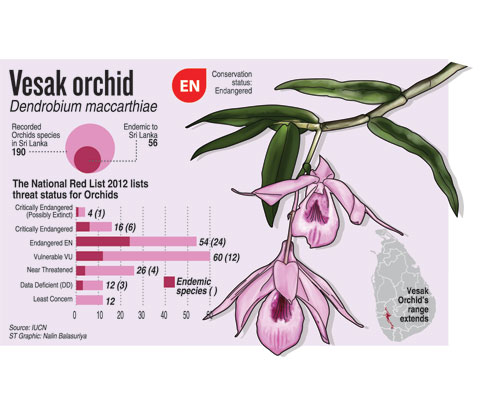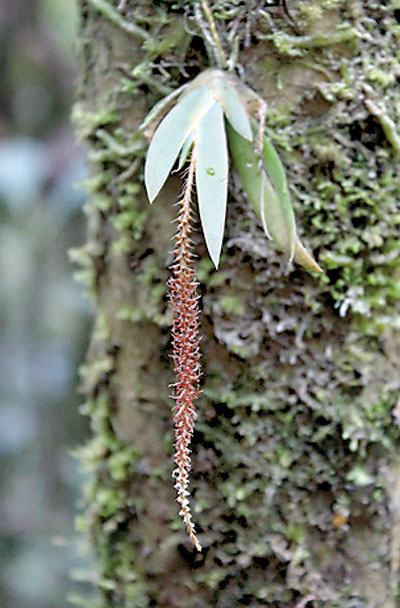News
Fading fortunes of the native Vesak flower

The Vesak orchid. Pix by Bushana Kalhara
A species of orchid that blooms in May and commonly called Vesak mal is becoming rarer. Plant experts say habitat loss and over collection from the wild are causing its decline.
Scientifically known as dendrobium maccarthiae, it may have got its local name because it blooms in the month of Vesak.
It is a light violet-pink flower with a paler lip and a purple blotch in the centre. It is a larger variety of wild orchid. The flower is about 6 centimetres long and 7.5 cm across. The photos accompanying this article were captured by Bushana Kalhara from the Kukulugala forest patch in Ratnapura two years ago in late May. He says the flowers were on the canopy about six metres above ground.
A specialist on orchids, Dr Suranjan Fernando, says the flower grows in south western lowland forest patches in Ratnapura, Kegalle, Kalutara and Colombo districts. The core area of the distribution is northern and western parts of the Ratnapura and Kalutara districts. It is also found in the western parts of Kegalle, southern part of Colombo and northern part of Galle district.
‚ÄúThe reason that this orchid is not found in other parts of the lowland wet zone is still a mystery,‚ÄĚ Dr Fernando says.
Like most of the other wild orchids, it is an epiphyte plant that grows harmlessly on tall trees getting moisture and nutrients from the air, rain, and sometimes from debris accumulating around it. The species usually grows in the upper parts of the tree trunks and large branches of mature trees.
It is a popular Sri Lankan flower and has been featured in stamps issued in 1950 and 1994. The orchid is also the provincial flower of Sabaragamuwa.
The former head of the Botanical Gardens, Dr Siril Wijesundara, reveals that there was a plan to use the Vesak orchid as a local alternative to the poppy to commemorate war heroes following the end of the war against Tamil terrorists in 2009.
It has caught the attention of collectors and exporters since the colonial days because it is endemic to Sri Lanka. Collecting the orchids from the wild for ornamental purposes led to its decline in the 1900s. This led to its listing as a protected species from 1937 with the inception of the Fauna and Flora Ordinance. Even the Forest Ordinance protects the Vesak orchid.
The former head of the Customs Biodiversity Unit, Samantha Gunasekara who is also an orchid lover says he once saw an ad on e-Bay that listed a plant for sale.
He was certain that it had been gathered from the wild.
Dr Fernando says field observations in the past 10 years have shown that the flower is in decline.
A number of other wild orchids are also threatened.
In Sri Lanka, orchidaceae is among the largest families in the country with 191 known species with 57 endemic species. Orchids grow in many habitat types in Sri Lanka, but highest number has been recorded in diverse ecosystems found in the wet zone.
According to the 2012 National Red List of Threatened Fauna and Flora, four orchid species are likely to be ‚Äėpossibly extinct‚Äô as they have not been recorded for a considerable time. Sixteen species are ‚Äėcritically endangered‚Äô, threatened with becoming extinct, while 54 species are categorised as ‚Äėendangered‚Äô. And 60 species fall into the ‚Äėvulnerable‚Äô category.
A number of showy orchids are also in demand. The Red List 2012 lists phaius wallichii (star orchid), rhynchostylis retusa (fox tail), and vanda tessellata are commonly collected by growers and flower enthusiasts. Habenaria crinifera (naarilatha), ipsea speciosa (nagamaru ala), anoectochilus spp. (wanaraja), zeuxine spp. (iruraja), are taken from the wild for medicinal purposes and because of various mythological beliefs associated with each species.
| Samanala reserve reveals new species Another new orchid species was added to Sri Lanka’s Orchid Checklist a few weeks ago. It was found in the Adam’s Peak (Samanala) Nature Reserve in Kuruwita-Erathna foot path in the Ratnapura district. The researchers Tharaka Priyadarshana and Ishara Wijewardhane say the orchid was first discovered on December 31, 2015, while they were conducting research with the National Wildlife Research and Training Center. Anusha Atthanagoda, Nandun Arangala, Asanka Jayasooriya and Pankaj Kumara too have been among those who supported this discovery according to a scientific paper. The new orchid belongs to an orchid genus called oberonia that has about 200 known species globally. They are also called fairy orchids. The new orchid is named oberonia meegaskumburae to honor the senior researcher Dr Madhava Meegaskumbura of the Peradeniya University.  The new orchid |

